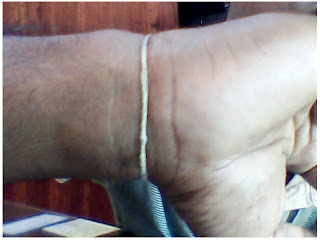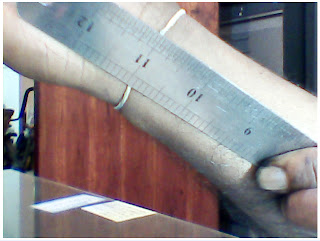
 System of Measurement is base on the owners hand lengths. That is called as hastha parimana. And finally convert to any desired units. The angula nad hasta are the main units of measurement.
System of Measurement is base on the owners hand lengths. That is called as hastha parimana. And finally convert to any desired units. The angula nad hasta are the main units of measurement.The unit of measurement used is generally the Hasta that equals 24 angulas. The hasta conversion is done diversely in different regions. The Ayadi Shadvarga is calculating by taking any of the standardized hasta measurements or using the actual hasta length of either the master, his/her spouse, eldest son or the architect (or contractor) designing the house.
However the angula is defined as the middle phalanx of the middle finger by Visvakarma and the yava measurement (8 grains placed side by side) works out roughly to 1 inch.
Visvakarma prescribe three different values for one Angula. It gives measurements of an Angula equal to 6 or 7 or 8 Yava. This variation is due to variation of peoples heights in different regions.

Peoples of some country called inch as a "Angala" in their language, still now.
When we using the Aayadi formulae for fixing the dimensions of a building, the risk of creating disproportionate spaces was eliminated. The Nakshathra formula should match with the birth Nakshathra of the owner. If possible it is better to match with all family members who wish to live in the house.
Manasara mentions the following:
1 paramanu = 1 atom8 paramanu = 1 ratha dhooli (molecule)
8 ratha Dhooli = 1 vaalagna (hair end)
8 valagna = 1 liksha (nit or egg of a louse)
8 liksha = 1 yooka (louse)
8 yooka = 1 yava (seed grain, barley grain)
8 yava = 1 angula = inch
12 angula, inch = 1 vitasti, feet
2 vitasti, feet = 1 hasta = 24 inches
24 angula = 1 hasta
4 hasta = 1 danda = 1 yasti = 1 dunu
8 danda = 1 rajju = 24x4x8 angula or 64 feet
10 hasta = 1 vansha
20 vansha = 1 nivarthana , 30 vansha = 1 nivarthana
2000 danda = 1 krosha
4 krosha = 1 yodun (something like killometer)
Various measuring units used in Vastu designs.
- One school of thought equates a hasta to 30, 31, 32, 33 inch and an angula to around 1-3/8th inch. Here, the hasta is measured from the shoulder to the tip of the middle finger. There is a another alternative method to calculate this. Take following three measurements and accumulate these three.
- length of the arm from the bottom of the elbow to the tip of the middle finger (approximately 17, 18, 19, 20 inch).
- Length of between thumb to smalest finger and it is called Viyatha (approximately 7, 8, 9, 10 inch)
- Four times of the length of the middle finger middle portion (approximately 1 inch)
- Another school of thought equates a hasta to 18 inches (and an angula to 0.75 inches ) Here, hasta is the length of the arm from the bottom of the elbow to the tip of the middle finger.
- A third school of thought eq uates a hasta to 24 inches and an angula to 1 inch. Here, the hasta is measured accumulated length of the upper and lower arm borns length.
Further research on the definition or usage of the Hasta measurement is needed to specifically determine whether 18 inches, 24 inch, 31 inch. This scribe generally uses the 24-inch Hasta.
Talamdna is the sculptural measurement. Here the length of the face from the top of the head is the unit. This length can also be taken as the distance between the tip of the middle finger and the top of the thumb of a fully stretched palm.
Method of measuring Hand length and Angula.
angula is defined as the middle phalanx of the middle finger and also defined as the end phalanx of the middle finger (some places). This is very easy to find out. This is around 1 inch (1 Angala). Please refer attached image to get an idea of measuring it by Vernier Caliper. The positioning is incorrect. That should be positioned to green line as indicated.
This angula measurement cannot use for work. You should calculate it by Vitasti measurement. You should take the measurement of ASTI = VITHASTHI (arm of hand). As in attached four figures. This should be 12 time of your Angula. You can back calculate angula by dividing it by 12. Then you can cross check the both. Then you can get the hand length by multiply this Vithasti by two.
Please remember all this should be done with your right hand.
Normally, Angula measurement seams to be wrong because it is very difficult to identify the correct start and end points of the middle phalanx. There are two lines in the middle of the finger. Correct line is closer side. Please refer the picture above with the vernier caliper. It indicate the incorrect measurement. Really it could be almost 2.5 cm (around 1 inch). But, You cannot touch and find this correctly. This is just a approximation. This could be wrong. So we should not depend on this Angula measurement.
The arm borne length is most probably correct. Because you can touch bone start point and end point correctly. Please refer above last skeleton picture for clear idea of end point. So, you should depend on the Vithasthi Measurement. Anyone can be easily get the correct value of the Vitasthi. Then back calculate the angula by dividing it by 12.
If any one is an average man, you are getting correct hand length of 24 inch. Inch have been design for an average man thousand years earlier in Vedas time.







No comments:
Post a Comment